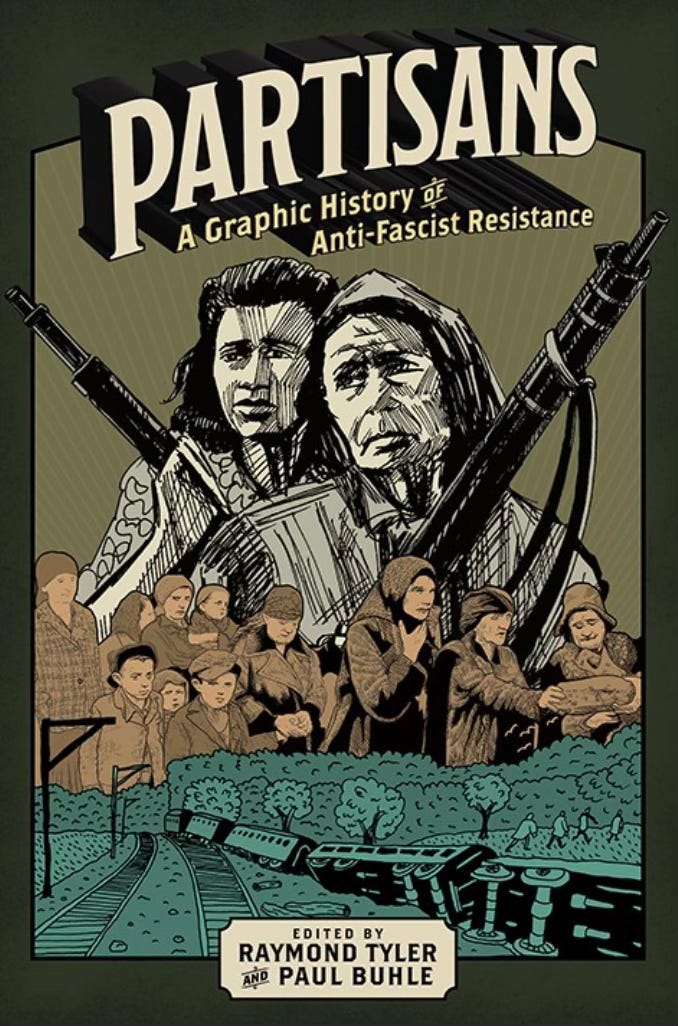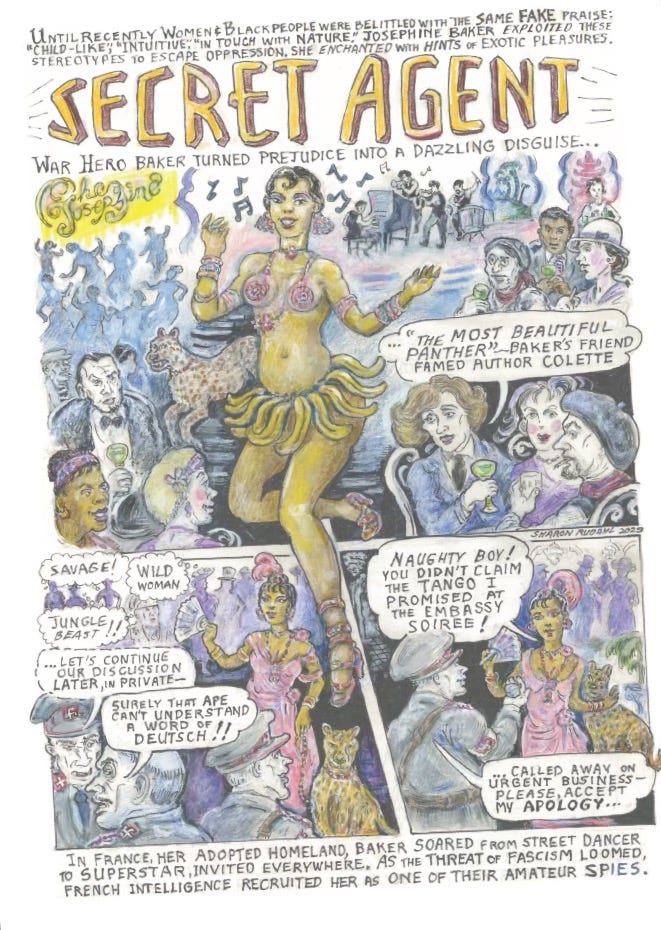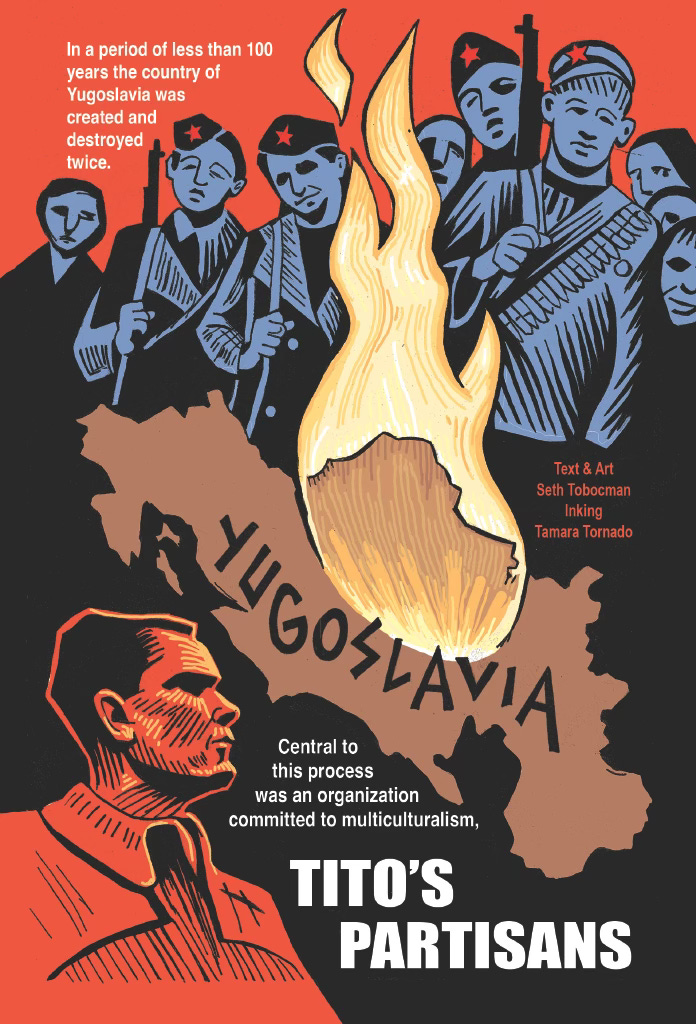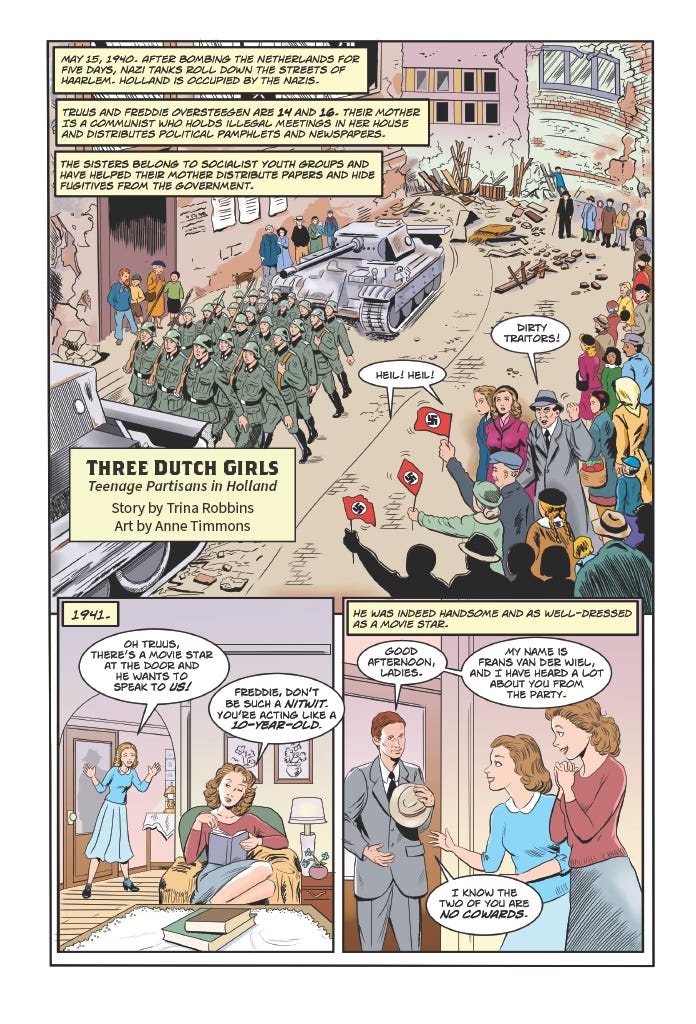Partisans: A Graphic History of Anti-Fascist Resistance, Edited by Raymond Tyler and Paul Buhle
Vivid and timely, this comic book tells Partisans' harrowing stories
Resplendent in a pink evening gown and matching feather in her hair, singer-dancer Josephine Baker charms audiences in Nazi-occupied France. The SS officers smile patronizingly. After all, as a Black woman, Baker can’t be very clever. Therefore, no threat to the Fatherland.
Mais non, non, Schutzstaffel! As beautifully portrayed by writer/illustrator Sharon Rudahl in “Secret Agent,” a chapter in the comic book Partisans: A Graphic History of Anti-Fascist Resistance, the Missouri-born Baker is a resourceful spy. She takes notes on the officers’ cocktail chatter, then passes the info along to the Allies—vital in helping them plan their 1942 invasion of North Africa.
Partisans, about anti-fascists in World War II, contains 11 chapters about such resistance efforts. Editors Raymond Tyler and Paul Buhle note that comics, by their nature, draw the reader into each frame, making us feel that we’re there. It’s fun to imagine sitting beside the Nazis while Baker croons her hit song, “Besame Mucho.” Translation: “Kiss Me A Lot.” Who knows? Maybe in her mind Baker was changing the words to, “Kiss my a—.”
As Tyler and Buhle relate, 1940s fascism originated in 1922 with Italy’s Benito Mussolini, who became dictator after violently suppressing opponents. Short and pale with a massive jaw, Il Duce suckered much of the population into seeing him as a reassuringly tough, macho leader. Those (goose-)stepping up to keep him company included Adolf Hitler in Germany and Francisco Franco in Spain.
Enter the leftist Partisans, who provided “resistance in all forms, including aid of all kinds to those escaping the fascist-controlled zones.”
Tossing a farewell beso to Baker, we’ll now visit 1940s Yugoslavia. In “Tito’s Partisans,” text and art by Seth Tobocman, inking by Tamara Tornado, we see the Ustaše, or Croatian fascists, gloating over freshly murdered victims. Fittingly, the artists show the two heads of the eagle in the Yugoslavian crest biting and clawing each other.
Josip Broz Tito, sporting the Partisans’ red star on his hat, brings peace. With a Croatian father and Slovenia mother, Tito supports the Partisan ideal of multiculturalism. Under his dictatorship, Yugoslavia enjoys prosperity and independence. But, to quote the chapter’s creators, Tito keeps his country “together by force. Can tolerance grow from the barrel of a gun?”
In “Three Dutch Girls: Teenage Partisans in Holland,” story by Trina Robins, art by Anne Timmons, gentle colours depict the three girls and their surroundings—which makes the eventual horrors they endure even more shocking.
This chapter begins in Haarlem, Holland. Movie-star-handsome Partisan Frans Van Der Wiel asks Truus and Freddie Oversteegen, aged 14 and 16, for help. Their assignment: lure a Gestapo agent to go for a walk. A deadly walk, needless to say.
No spoilers, except to say there are plot twists and much suspense. And kudos to the authors for showing that, despite the circumstances, the girls are still girls. Given spending money by Van Der Wiel for treats as they wait for the Gestapo agent, they get carried away and order more sundaes than they can pay for.
A third girl, Hannie Schaft, joins the sisters in their subterfuge. Eventually, the Nazis get wise to one of the three and kill her. Another grows up to be a sculptor and creates a statue to honour her murdered comrade: you can see it today in Haarlem’s Kenaupark.
Partisans is at once fascinating history and a timely warning. Noting that “fascism once again seems to threaten everywhere, including the US,” Tyler and Buhle urge a continued Partisan spirit. Or, to paraphrase Josephine Baker, take the blows—but keep your chin up. And, of course, resist mucho.
About the Authors
Raymond Tyler is a comics writer from Appalachian Georgia now residing in Nyack, New York. Tyler is a longtime social justice and labour activist, bridging “history from below” with comics. His most recent work is Black Coal and Red Bandanas: An Illustrated History of the West Virginia Mine Wars.
Paul Buhle is a retired senior lecturer at Brown University; the authorized biographer of Trinidadian historian and journalist C.L.R. James; co-editor of The Encyclopedia of the American Left; and editor of nearly 20 nonfiction graphic novels. Buhle lives in Providence, Rhode Island.
About the Reviewer
Melanie Jackson is a Vancouver freelance writer/editor. She’s also the award-winning author of middle-grade/YA suspensers, including Orca Books’ Dinah Galloway Mystery Series, and several chillers set in amusement parks. Visit Melanie at The Writers’ Union of Canada site.
Book Details
Publisher: Between the Lines Books, August 2025
Language: English
Paperback: 148 pages
ISBN: 9781771136525







